

Dealing with the Depression, war, rescuing cities, and contemporary architecture
by Tony P. Wrenn, Hon. AIA
No previous decade in AIA history evidences the changing years as
does 1937-1946. In January 1937, a halt was called to a meeting in
the Octagon, so that a “radio machine” could be brought
into the room, the work table be covered with linen, and drinks
served. The directors awaited a broadcast from England, and
“what more fitting place to hear this broadcast than The
Octagon, teeming with historical associations.” It was, after
all, the very room and the very table, where President James
Madison had in 1815 signed the Treaty of Ghent, ending the War of
1812 between Britain and America. There the directors sat,
“all listening to the firm, strong voice of a young King, a
thousand leagues away, renouncing the throne of a great
empire.”
 Then, off with
tablecloth and back with ashtrays, papers, and discussion of AIA
issues. The Fifth Edition of the Standard Documents was approved,
and housing was discussed. Would the construction industry pattern
itself after the automobile industry and produce more trailers than
houses? Frederick Ackerman was afraid that was in our future and
wrote, “Lower income groups are continually on the move from
one area of decay and obsolescence to another.” If trailers
did indeed become a predominant method of housing, he asked,
“Precisely what problem is solved ...?”
Then, off with
tablecloth and back with ashtrays, papers, and discussion of AIA
issues. The Fifth Edition of the Standard Documents was approved,
and housing was discussed. Would the construction industry pattern
itself after the automobile industry and produce more trailers than
houses? Frederick Ackerman was afraid that was in our future and
wrote, “Lower income groups are continually on the move from
one area of decay and obsolescence to another.” If trailers
did indeed become a predominant method of housing, he asked,
“Precisely what problem is solved ...?”
Taking a stand
It was in 1937 that a decades-long battle of the AIA began. “A
Bill to revise the central part of the Capitol building at
Washington has again been presented in the Senate,” the Board
noted. It had been presented before, but tabled. The AIA had taken
no stand. Now that would change, but AIA committees were not of one
opinion. Edgerton Swartwout, of the AIA Committee on the National
Capital, stated that “The proposed extension is to provide
needed legislative accommodations, to give proper visual support to
the dome, and to replace the crumbling and defective sandstone of
the older portions with enduring material, white marble....This
extension and restoration will be of incontestable benefit to the
Capitol, to Washington and to the nation.” Officially the
Committee noted “it is not the function of the American
Institute of Architects to act as arbiter of such disputed
questions.”
Leicester B. Holland, chair of the AIA Committee on Preservation of
Historic Buildings, strongly disagreed. “To sacrifice the
present very beautiful composition which embodies the history of
American architecture, simply to make it more academically correct,
or just for a love of marble, seems to be frankly a piece of
parvenue vandalism. If this be Architecture, then Architecture in
America is not the goddess I have thought her, but a hussy who
would swap her honor for a new spring hat.”
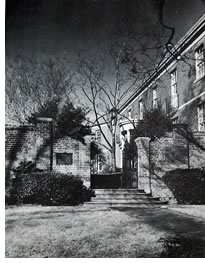 The Institute,
meeting in Boston in June, decided that taking stands was one of
its functions, and stood with the preservationists. “Resolved:
That the American Institute of Architects in convention assembled,
expresses itself as opposed to any material alteration of the
central portion of the Capitol, either in form or material.”
Perhaps the report of the Committee on the Preservation of Historic
Buildings influenced some. Its Historic American Buildings Survey,
began in 1934, had seen employed, with federal funds, hundreds of
architects and draftsmen who had recorded a total of 2,700
structures “recorded in 13,700 sheets of measured drawings and
3,550 structures photographed in 16,150 negatives. In addition,
cards for some 2,700 structures still to be recorded are on
file.” HABS employed, it reported in 1939, a “continuous
average of 200 men.”
The Institute,
meeting in Boston in June, decided that taking stands was one of
its functions, and stood with the preservationists. “Resolved:
That the American Institute of Architects in convention assembled,
expresses itself as opposed to any material alteration of the
central portion of the Capitol, either in form or material.”
Perhaps the report of the Committee on the Preservation of Historic
Buildings influenced some. Its Historic American Buildings Survey,
began in 1934, had seen employed, with federal funds, hundreds of
architects and draftsmen who had recorded a total of 2,700
structures “recorded in 13,700 sheets of measured drawings and
3,550 structures photographed in 16,150 negatives. In addition,
cards for some 2,700 structures still to be recorded are on
file.” HABS employed, it reported in 1939, a “continuous
average of 200 men.”
Federal architecture and the employment of private architects for
its design and construction remained an aim. President Franklin
Roosevelt noted, in dedicating a Post Office in Poughkeepsie, N.Y.,
in October, “All over the United States there are scattered
the most terrible monstrosities of architecture perpetrated by the
Government on the people of the United States.” The AIA was
quick to applaud. President Charles D. Maginnis wrote “The
deplorable failure of ... this country to avail itself of the
artistic resources that have been at its command has long been a
source of regret and concern” to the Institute. He offered the
services of the AIA and Roosevelt responded acknowledging AIA
efforts, saying “We are of one mind that the architecture of
the United States Government should express the highest standards
of design and construction, be an influence on the cultural life of
America, and elevate the general standards of good
taste.”
Ask not …
In 1938, Francis P. Sullivan introduced an idea that
President John Kennedy later would make famous. “I believe
that it is our duty when these men ask The Institute what it has
done for them or what it will do for them, to tell them frankly,
‘You are missing the whole point of The Institute’s
purpose’. The real question is, ‘What can You and what
will You, through The Institute, do for the public good and for the
good of your profession?’”
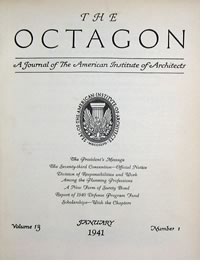 In New
Orleans, the AIA gave its Gold Medal to Paul Cret and argued the
future of architecture. In presenting the award to Cret, Ralph
Walker echoed the idea suggesting that “symbols are evidently
more important than bread. Long after a people and their means of
sustenance is gone, stone rests upon stone and tells a story more
enduring than last year’s harvest or today’s
sowing.” At the same time he lauded Cret for being no copyist.
“His work ... is remarkable for three things—good
planning, individuality and good proportions. There are no loose
ends. The character of each building is complete within
itself.”
In New
Orleans, the AIA gave its Gold Medal to Paul Cret and argued the
future of architecture. In presenting the award to Cret, Ralph
Walker echoed the idea suggesting that “symbols are evidently
more important than bread. Long after a people and their means of
sustenance is gone, stone rests upon stone and tells a story more
enduring than last year’s harvest or today’s
sowing.” At the same time he lauded Cret for being no copyist.
“His work ... is remarkable for three things—good
planning, individuality and good proportions. There are no loose
ends. The character of each building is complete within
itself.”
By 1939, the Board reported architectural registration laws in 40
states and in the territories of Alaska, Hawaii, the Philippine
Islands, and Puerto Rico, with Arkansas and Alaska having adopted
laws that year, and seven of the remaining eight states attempting
to pass them.
Preparing for war
Even as the Depression lingered, conditions in Europe
added to the anxiety felt by architects. Outgoing President
Maginnis told the convention that “we should hold our course
in the belief that man has not lost his soul and that his world
will presently come again to sanity.” Incoming President Edwin
Bergstrom hoped “our country will not be involved by untoward
events beyond its borders,” but announced he would appoint a
preparedness committee to determine how to make the profession of
immediate service to the government.
Steps the Institute might take to meet the coming emergency were
discussed, among them a survey of some 14,000 architects and
offices, requesting “each to indicate the extent and character
of its practice, its personnel, equipment and facilities and the
type of work it knows it can best perform.” Still housed in
the Institute archives, the survey responses offer a mirror,
reflecting how architects viewed themselves and their work. The
Institute agreed to suggest representatives who might be asked to
work with the government on carrying out defense programs. It would
shortly appoint a special representative, with offices in The
Octagon, to report to the membership on government plans and
programs undertaken as the nation moved toward war.
Ever prescient, AIA Washington’s Air Raid Protection Committee
suggested to those who said it can’t happen here, “for
the sake of argument let us suppose that some day a far-flown plane
drops something more substantial than leaflets in the neighborhood
of one of our seaports, or on some inland industrial city.”
What then? Committee Chair Horace Peaslee suggested studying how
buildings “can be evacuated, safely and quickly,” and how
a bomb-proof shelter should be constructed, ventilated, and
serviced. In a series of roundtable discussions, the committee had
dealt, he reported, with adapting parking garages for shelters, the
type of shelters required, evacuation of citizens to camps in the
country, and the possibility of legislation requiring protection of
tenants and employees, with severe penalties for not providing safe
buildings.
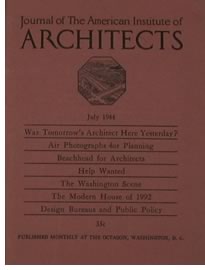 In a bit of
good news in 1940, the AIA Board announced awarding of a contract
to construct a new headquarters building behind The Octagon,
something approved in 1926. Dan Everett Waid, Dwight James Baum,
and Otto R. Eggers were the architects. Most of the money would
come from a trust fund established in 1936 by Waid, whose
“gifts aggregate almost four-fifths of its cost.” The
L-shaped brick building, two stories over a basement, would wrap
around the Octagon, not infringe on the existing garden, and give
the Institute not just the feel of an academic village, but, in
time, rental income as well.
In a bit of
good news in 1940, the AIA Board announced awarding of a contract
to construct a new headquarters building behind The Octagon,
something approved in 1926. Dan Everett Waid, Dwight James Baum,
and Otto R. Eggers were the architects. Most of the money would
come from a trust fund established in 1936 by Waid, whose
“gifts aggregate almost four-fifths of its cost.” The
L-shaped brick building, two stories over a basement, would wrap
around the Octagon, not infringe on the existing garden, and give
the Institute not just the feel of an academic village, but, in
time, rental income as well.
“War has been declared…”
With his first report, Washington representative Edmund R.
Purves confirmed that “The country is engaged in a program of
astronomical proportions and incidentally we are involved in a
shooting war.” In his second report, in December of 1941, he
wrote, “Since the last report was made to you, war has been
declared.” Purves said his office “is in a position to
help others avoid those embarrassing situations which may result
from action based upon inaccurate information,” but warned,
“We do what we can for the profession and we try to open as
many doors as possible through which the architects may enter.
However, it is not within our province to select architects for
jobs and we wish to emphatically call to your attention that on no
accord do we select or aid in the selection of architects.”
Later, before receiving his military commission, Purves wrote in
one of his last reports “This office is always ready to guide
those who come to Washington and can point the way and give you the
benefit of the contacts it has made and the relations it has
established. But very definitely your future lies in you own
hands.”
For a lack of “pithiness, ... aptness, ... freshness” in
his last reports, he apologized. “A sort of pall or a thin but
effective smoke screen appears to have been drawn across the news.
It is not the fault of the authors of the columns. The damp paw of
censorship is at work and those of us who are here in Washington
are driven to draw our own conclusions and make our own
surmises.” D. K. Fisher Jr., followed Purves as Washington
representative.
At its 1942 Convention in Detroit the Institute gave a special
award to Albert Kahn, who made even Ford and Chryslers assembly
plants handsome. “Exponent of organized efficiency, of
disciplined energy, of broad visioned planning ... Master of
concrete and of steel, master of space and of time, he stands today
at the forefront of our profession in meeting the colossal demands
of a government in its hour of need.” During the presentation,
in the Hotel Statler’s Grand Ballroom, when General William S.
Knudsen was praising Kahn’s contributions to the war effort,
“Sirens wailed—a practice blackout had begun in Detroit,
the brilliant lights of the Ballroom were gradually dimmed making
an unforgettable picture of the heroic figure of General Knudsen in
the reflected light of the shaded lamp before him.”
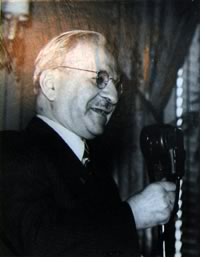 Setting the
Foundation
Setting the
Foundation
The Detroit award was probably the preliminary to an AIA Gold
Medal, but Kahn died a short time later. Just before his death he
had written the AIA “I cannot help but think that The
Institute would do a tremendous good to the profession if more
frequent recognition were given members for outstanding
work ...” He offered $10,000 to begin such a program, funds
which led to the 1943 formation of The American Architectural
Foundation, still active today, though chances are today few know
Kahn made it possible.
That same year, 1943, the Board of Directors sought a monthly
publication “which would be a more effective instrument of
expression than is possible within the limitations of the annual
appropriations ... The present Octagon was established in 1929 as a
bulletin of the Institute to transmit official notices to members,
to report activities of the Board and of the committees and in
other ways to advise on the activities of the organization.”
The Board asked the membership what it would like the new magazine,
which would take advertisements, to be. One question was
“Would you favor a change in form of The Octagon to,
say, Readers Digest or some other size?” Obviously
Readers Digest won, for the Journal of The American
Institute of Architects was that size when it began
publication in January 1944, with Henry Saylor as its editor.
The Washington representative continued his reports, noting the
need of the nation to deal with “those men who return to the
United States, like wreckage cast upon the shore ... That problem
was severe during World War I. Following World War II, gentlemen,
it is going to be a problem that you can’t even conceive
of.” He reported problems commissioned architects had to deal
with in the field: men who could not read or had never used a
telephone, and almost no one knew what an architect was, or what
one did.
The Washington representative proposed to deal with the problems,
and did so in print, “under the following headings: education;
what we choose to call the aesthetic phases of architecture; lack
of publicity and public recognition; and lack of professional
leadership.”
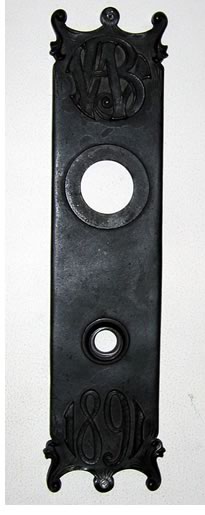 Soldiering
on
Soldiering
on
In 1944, the Institute was asked to abandon its convention, and
“that request was promptly and patriotically met.” Even
Board meetings were difficult, for “war activities and
military personnel have so crowded our principal cities.” In
April, 1945, at the 77th Convention in Atlantic City, “in
strict conformity with the requirements of the Office of Defense
Transportation ... [attendees] were limited to fifty.”
Still, the Institute continued. Lively and provocative articles
appeared in The Journal, as diverse as Edwin Bateman
Morris on “What Next for Architecture”: “While no
one can make predictions with accuracy, it is almost a certainty
that the argumentative phase of the Modern style is at an
end”; Henry Churchill on “What Shall We Do With Our
Cities?”: “A city exists for two things only; it is a
place in which people earn a living, and it is a place in which
people live and play. If a city fails in either...”; and Guy
Study on “Louis H. Sullivan—Fifty Years Afterwards”:
“His was a personal triumph mixed with futility; he was indeed
a brilliant meteor which shot across the firmament of art, but not
a planet by which American architecture may chart its
course.”
And in a gutsy move, the AIA Committee on Education asked Turpin C.
Bannister to compile a list, often reprinted, of “One Hundred
Books on Architecture.” It was suggested all libraries should
have these books. Twenty-five books were identified with asterisks
as a core collection for small libraries.
Striving for the future
In 1946, breaking with precedent, the AIA awarded the Gold Medal to
a deceased architect, Louis Sullivan, in, of all places, Miami
Beach. “He fought almost alone in his generation, lived
unhappily, and died in poverty,” the citation read. “But
because he fought, we today have a more valiant conception of our
art. He helped to renew for all architects the freedom to originate
and the responsibility to create.” The Sullivan Gold Medal,
Saylor would write in The Journal “brought assurance,
at a later session, that the Institute would strive in the future
to honor the living, year by year.” Some 600 attended, and the
convention ran overtime. There was peace, and the question of what
to do with it. Saylor concluded his report “And in six
early-morning flights of the big Douglas and Lockheed planes, well
over a hundred soared across to Havana to see what that city and
Cuba in general could offer to top off the Convention of
1946.”
At the beginning of the decade, the Board listened to Edward
abdicate. At the end of the decade, they discussed the atom bomb
and Oak Ridge, Tenn. There, “starting with 10,000 acres of
farmland, Skidmore, Owings & Merrill, architects of Chicago and
New York, designed and built the city in less than a year, at a
cost of something less than $500,000,000. Oak Ridge now [October
1945] has a population of over 60,000—the fifth largest city
in its state. The architects laid out the plan as a group of 12
neighborhood communities, each with its school, shopping center,
church, and amusements. Centrally located, to serve the 12
neighborhood groups are the city hall, two large high schools and a
business district.”
Had the 20th Century finally arrived?
Copyright 2005 The American Institute of Architects. All rights reserved. Home Page

